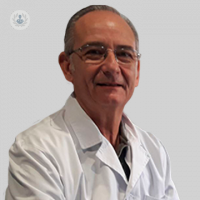Roncar no es sinónimo de sueño tranquilo y reparador
Written by:Sleeping is essential for life. We spend about a third of it in that state; about 25 years. The objective of the dream is to recover energy and energy spent during the day and prepare for a new day. If we tried to suppress the dream, alterations would appear so serious that they would take us to death. People who sleep badly have significant physical and mental changes.
During sleep, our upper airways tend to close during inspiration for relaxation. The body has reflexes that prevent this collapse. The specialists in Pneumology establish that circumstances such as the increase of fat in obesity, small anatomical variations (retrognathia, short neck, large tonsils, etc.), or other factors, make these reflexes do not work properly and our airway is more prone to closure.

Why grunt?
Snoring is the noise that is produced by the vibration of the soft palate during sleep. It would be one of the manifestations of partial closure of the airway. Snoring daily is very frequent. Half of the men and a quarter of the women do it. It is not clearly demonstrated that snoring in isolation, without other manifestations, is a disease. However, it is an inconvenience for many people. It seems that habitual snorers have a less refreshing sleep and may be an expression of a more important problem like an apnea syndrome during sleep.
If the occlusion of the airway reaches greater degrees, our breathing begins to compromise and hypopneas and apneas appear. A hypopnea is to stop breathing partially to a defined degree and an apnea is a total closure of the airway, in both cases at least 10 seconds long. These events prevent normal sleep and rest because they force us to wake up frequently, although we are not fully aware and cause decreases in the oxygen saturation of the blood.
When these small but repetitive episodes of suffocation (more than 5 times per hour) are associated with excessive sleepiness, cognitive-behavioral, respiratory, cardiac, metabolic or inflammatory disorders, we define it as Hypopnea Sleep Apnea Syndrome (SAHS), also known as the syndrome of apnea or obstructive sleep apnea syndrome.
Sleep Apnea Hypopnea Syndrome
SAHS is a breathing disorder during sleep that occurs with frequent episodes of interruption in breathing. The exact cause is unknown. We know that the upper airway closes as a result, in part, of muscle relaxation during sleep, or because of an anatomical obstruction at the level of the pharynx-gold (large tonsils, obesity, goiter, nasal alterations, etc.). ).
SAHS is a very frequent disease, it is estimated that in Spain there are between one and two million people who suffer from it.
When sleep apnea manifests
In adults, it manifests during the night or sleep, with loud snoring, interruptions in breathing and restless sleep. Sometimes we become aware of one of those episodes of apnea and wake up with a feeling of intense suffocation that will disappear in a few seconds. Need to urinate several times at night. During the day, there is a daytime hypersomnia that can become serious (driving, talking, during work), a feeling of being always tired, depression, irritability, lack of concentration, impotence, restless sleep or morning headache. It can even have cardiovascular consequences such as lack of control of blood pressure, uncontrolled arrhythmias, cardiac or cerebral ischemic processes.
In children, the most frequent nocturnal manifestation is snoring, a child should not snore. We must be alert to manifestations such as: irritability, lack of school performance and attention, daytime hypersomnia, night sweats, enuresis. May predispose to growth retardation and hypertension in adulthood.

Diagnosis of sleep apnea
The diagnosis is relatively simple and painless. We need to do a sleep study of which there are two modalities: respiratory polygraphy and polysomnography. Respiratory polygraphy is usually performed at the patient's home. It consists of the placement of a portable device of small size with sensors that usually record the flow of air through the nose, the oxygen saturation of the blood, respiratory movements, pulse, position and snoring. Polysomnography requires a specialized sleep laboratory where the patient should sleep.
In addition to the records that are made in the respiratory polygraphy, other variables are added such as the electrocardiogram, electroencephalogram, eye movements, mental activity and mental legs. This analyzes the real dream of the person and can better characterize some sleep disorders that could not be defined with respiratory polygraphy. After analyzing the different signals we arrive at the confirmation and degree of severity of the SAHS.
Does sleep apnea have a cure?
SAHS is a chronic disease for which we have no cure but effective treatment. Treatment in adults is mainly done with CPAP (Continuous Positive Pressure in the Airway). This is a device that supplies air pressure through the nose that, by preventing the closure of the airways while we sleep, apneas do not occur, snoring disappears and therefore restoring sleep and normal rest. Symptoms disappear or improve significantly in most cases. Control of blood pressure improves. It is usually heard in the consultation: "my life has changed" or "I can not sleep without my mask".
In contrast, in children the treatment is usually surgical since most of the origin of SAHS is secondary to adenotonsillar hypertrophy; the need to indicate CPAP is exceptional.


